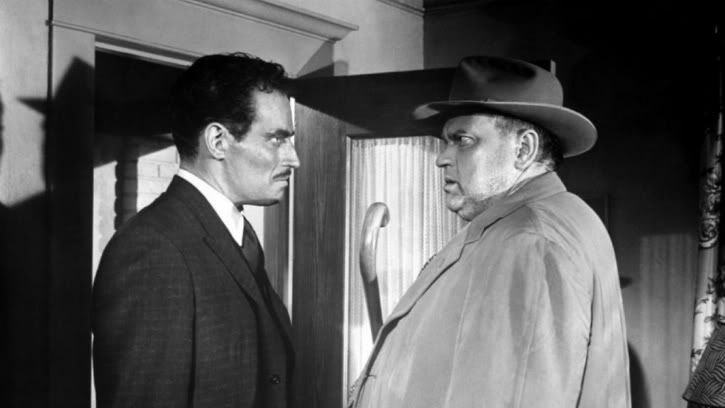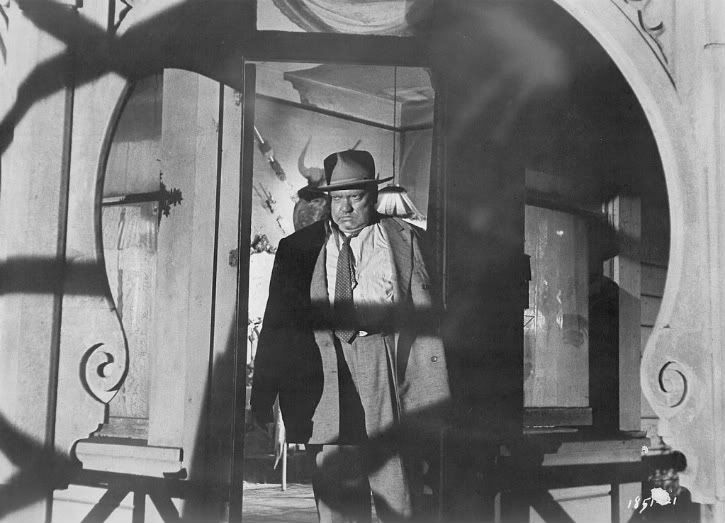
Touch of Evil (1958) directed by Orson Wells, is the last of my college essays. It is a fitting end for my nostalgic look at film noirs because it is considered the last true noir movie. Anything after it is considered neo-noir and is merely reminiscent of the genre. Two movies that I looked at earlier, "Stranger on the Third Floor" and/or "The Maltese Falcon." are considered the first noirs.
But, don't worry, I still have a paper (longer essay) I wrote for the class to share. The only clue I'll give is it's one of those neo-noirs and you might have heard of it. Plus, there are a lot more noirs I'd still like to look at, so I'll just have to start writing again.
This is my reaction paper from a college film noir class. Originally written in 2003.
Spoiler...
One of the most memorable things in this film is the opening sequence. Even with today’s technology, I doubt many directors would attempt to film a tracking shot so complex. The scene was filmed many times and you can see the sun rising in the background of the cut used, because it was the last take of an all night shoot.
To me, the film is different than other film noirs because its characters somehow seem much more indomitable. Film noir is usually about some poor guy who finds himself in over his head and screwed by a powerful villain or society. However, this film is about two equally powerful characters clashing. Miguel Vargas (Charlton Heston) and Capt. Hank Quinlan(Orson Wells) are both highly respected figures. As Quinlan says when it becomes clear they are enemies, “somebody’s going to have to give in this case or somebody’s going to be ruined.”
Throughout the course of the film, it seems as if Quinlan and Vargas are more than just powerful characters; at times they seem invincible. A henchman throws acid at Vargas from close range, and somehow misses. The other detectives who follow Quinlan resemble a lost gaggle of geese because they are constantly talking in an almost unintelligible fashion and looking to Quinlan for all the answers. Vargas takes on an entire bar of henchman and wins. The movie seems to be saying that when an evil man is allowed to become as powerful as Quinlan, he can only be defeated by an equally powerful force of good.
I found the gangsters in this movie to be very interesting. They were part of a Mexican crime family, but only about two of them were Spanish. I think they were drug dealers, and I thought it was funny that no one in the crime family was allowed to do drugs. In other words, they understood the dangers of drug use and made their money by selling them to an unsuspecting American market.
There were a few details in the set design that really made a repeat viewing worth it. In the scene where Quinlan murders Uncle Joe Grandi, there is a sign on the door that says “Stop. Forget Anything?” This hints at the fact that Quinlan has forgotten his cane at the murder scene. Earlier in the film, Vargas makes a phone call from a store run by a blind woman. In that scene, there is a sign in the background that says “If you’re mean enough to steal from the blind, help yourself.”
Sgt. Menzies was the best character in the film. At the beginning of the film he is bright-eyed and chipper and thinks the world of his partner Quinlan. By then end of the film though, he shoots and kills Quinlan. This transformation is subtle and well done. For instance, as the film goes on, Menzies stops shaving and becomes more and more reserved. One line I found especially haunting is when Menzies says, “Hank Quinlan made me an honest cop.”

No comments:
Post a Comment